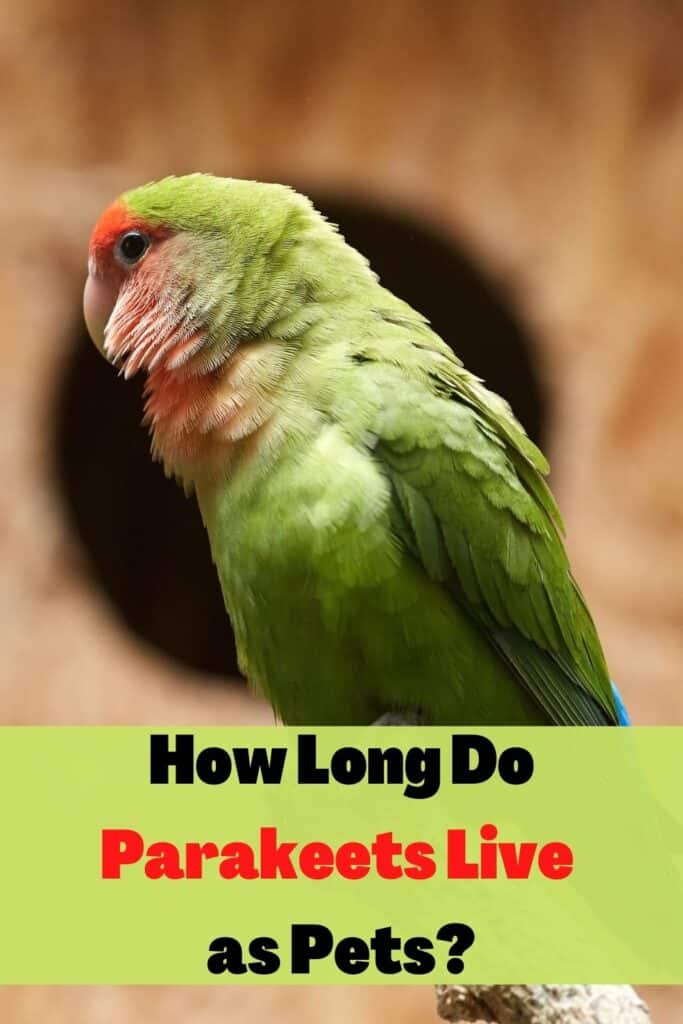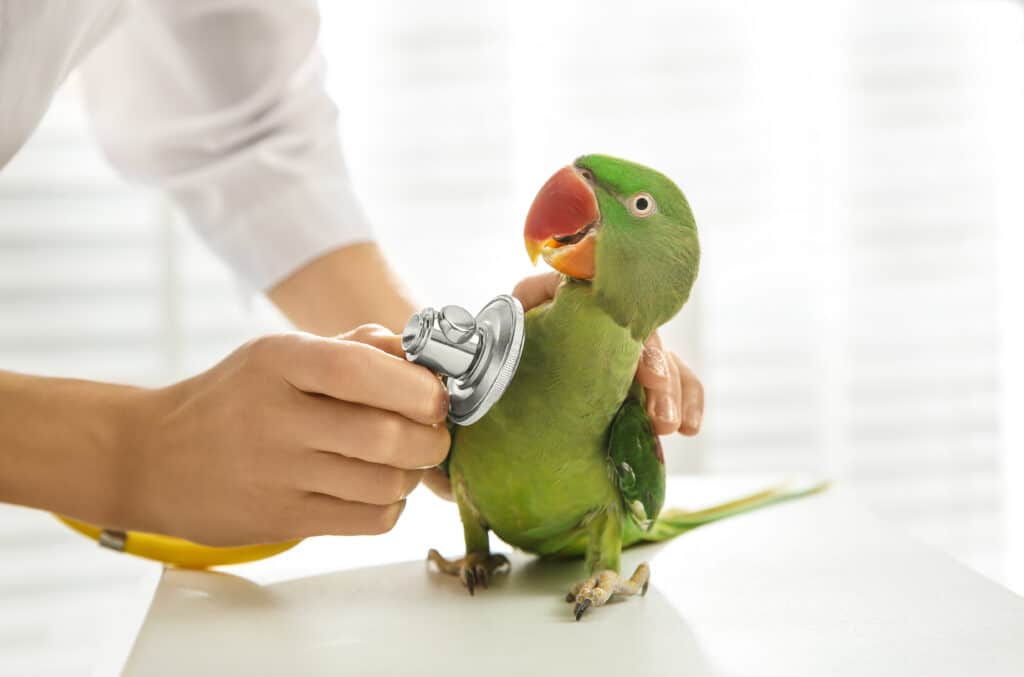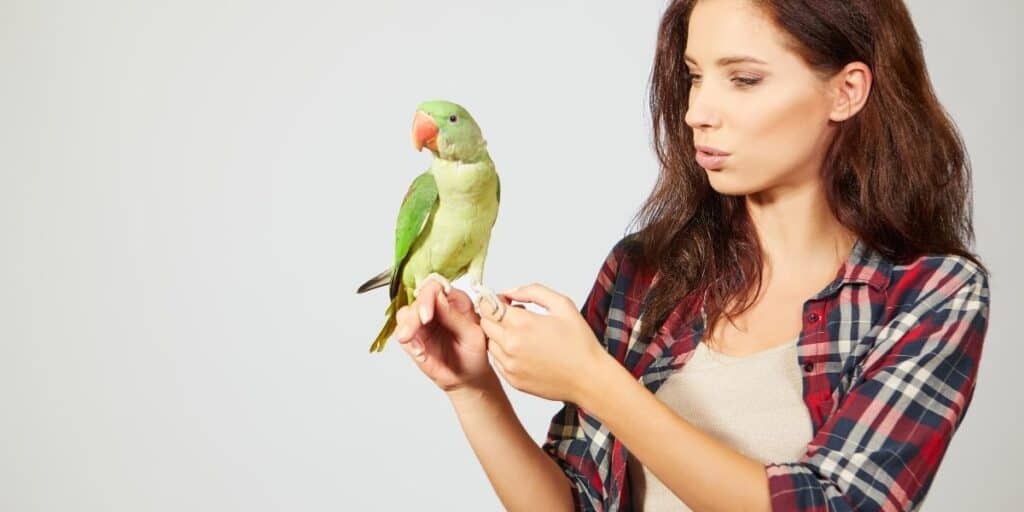First recorded in 1805, parakeets are some of the most popular pet birds in the world today, owing to their miniature size, low maintenance needs, and impeccable mimicry prowess.
Did you know, parakeets aren’t one just specific breed? There are around 115 different species of these slender birds with tapering tails.
With such a wide variety of Parakeets both in the wild and kept in captivity, it’s hard to put an exact length on the lifespan of a parakeet. It is not uncommon to see a Parakeet kept as a pet live on average 10-12 Years with some species living a long and happy life up to 20 Years.

Table of Contents
How Long Do Parakeets Live as Pets?
Like always, there’s no one definitive answer to how long do parakeets live as pets. The answer varies depending on the species.
A Monk parakeet can live up to 15-20 years, while a plain parakeet’s average lifespan is 15 years. On the other hand, a budgerigar’s life expectancy is anywhere between 5-10 years.
Improper care can shorten your parakeet’s life by a few years. Now that might not seem like a lot in human years, but in bird years, it can be quite upsetting.
| Type of Bird | Lifespan Pet |
| Budgie | 15-20 Years |
| Lovebirds | 10-15 Years |
| Amazon Parrot | 25-75 Years |
| African Gray Parrots | 40-60 Years |
| Canaries | 10 Years |
| Cockatoos | 18-60 Years depending on species |
| Macaws | 30-50 Years depending on species |
| Pionus Parrots | 20-25 Years |
| Lorikeets | 12-30 Years |
| Finches | 4-9 Years |
| Eclectus Parrots | 25-50 Years depending on species |
| Cockatiels | 8-15 Years |
Parakeet’s Age Calculator
Once again, there’s no one-size-fits-all approach when it comes to ascertaining your parakeet’s age.
But it is commonly believed that 1 parakeet year translates to 5-6 human years on average.
You can calculate the age yourself.
At the time writing this blog, the average human life expectancy is around 80 years. Now, divide 80 by your parakeet’s age to find out how long it will live.
For example, in case of a plain parakeet:
80/15 = 5.3 years
So, one year of age in plain parakeets roughly equals to 5.3 human years!
Still, it’s just a rough estimate. So, look out for signs of aging in your parakeets so you can take better care of them.
How to Know if My Parakeet is Getting Old?
Usually, parakeets reach their full maturity in 1-2 years.
The above-mentioned calculating method indicates how long do parakeets live as pets or how old they are right now. Still, you’d love to be 100% sure, right?
There are few signs you can look out for an accurate estimation of your parakeet’s age.
Examine Parakeet’s Cap Feathers
Young parakeets that are less than 3-4 months old will have stripes on the head’s cap, stretching all the way to the beak’s base. At around 3-4 months of age, it will experience the first molt, and the top feathers on the cap will be replaced.
Now, instead of the stripes, there’ll be a cap of feathers. The color depends on the parakeet’s breed.
If your parakeet’s stripes or bars haven’t gone through the first molt, consider it very young and give proper care.
Note: Albino, Lutino, and Recessive Pied breeds of parakeets are exceptions to this rule, as they don’t have the regular feather markings.
Watch the Color of the Iris
In parakeets, eyes can be the window to the health. Yes, gauging the eye health can be your answer to how long do parakeets live as pets. Normally, young chicks have black eyes because of the excess melanin.
They don’t have irises either. So, if your parakeet has pitch-black eyes, you can assume that it is 5 months old or younger.
As they grow older, between 4-8 months, parakeets will develop dark gray irises. It’s usually only visible in sunlight. Similarly, mature parakeets will have light gray or brown irises.
In that case, you can safely suppose that the parakeet’s at least 8-12 months old or older.
Note: Red-eyed parakeet varieties like Lutino, Fallow, Albino, and Lacewing are exceptions to this standard. They sport pink irises! Likewise, parakeets like Recessive Pied and Dark-Eyed Clear have dark plum eyes that don’t change color with time.
Check the Color of the Beak and Cere
Baby parakeets younger than three months will have darker beak and cere because of high levels of melanin.
As they grow older, the dark tone of the beak and cere will fade and result in blue, violet, pink, or light brown colors depending on the parakeet’s breed.

Study the Signs on the Bird’s Leg Band
Well, it’s obvious and the easiest way to find out your parakeet’s age. Unless you’ve rescued one from the wild, parakeets will have a leg band that will help you identify the bird’s origin and age.
In most cases, the first and second sets of letters are reserved for the company that issued the bird band and breeder, respectively.
Similarly, the birth year is symbolized by the third set of numbers on the leg band, and the fourth set of numbers shows the bird’s pedigree number.
If you’re still not quite sure about your pet parakeet’s age, don’t hesitate to contact the pet store or the breeder. They will have the necessary documentation to verify your bird’s age.
Note: Sometimes, the breeder will try to sell you an older parakeet passed off as a younger one. That’s because the younger ones are more valuable and bring a lot of money. Don’t forget to study the differences between a more youthful and older parakeet with the help of the signs mentioned above.
Health Conditions Parakeets Are Susceptible To
Aside from physical injuries from accidents, your parakeets are prone to a number of other health conditions that are quite similar to other medium or small-sized parrots.
From a simple wound to a severe infection, a health complication can shorten your parakeet’s life dramatically.
Parasites
Parakeets with a scaley build-up on the legs and beak are prone to mites like knemidokoptes. It can cause permanent deformities if not treated on time with antiparasitic drugs like ivermectin.
Also, protozoal parasites such as trichomonas can attack the throat and result in lost appetite, coughing, and sneezing. Other than that, parakeets are also vulnerable to intestinal parasites like threadworms and roundworms.
Candidiasis
Parakeets can also catch a yeast infection called candidiasis that can flourish anywhere in your pet’s digestive system.
Its symptoms generally include loose droppings, pungent vomiting, and listlessness—similar to any other yeast-induced infection.
Candidiasis can only be treated with medications that counter bacteria. Thus, you need to visit the vet for that. During the recovery time, plan your parakeet’s diet carefully and avoid giving anything sugary.
Injuries
Parakeets are inherently curious creatures. So, it’s not unusual for them to run into a little accident during one of their exploration sessions.
While it’s harmless most of the time, we can’t completely rule out the possibility of food poisoning or bodily injuries.
If your parakeet eats something it’s not supposed to, toxicity will create immediate and grave impacts. That’s why you must make sure that your home is birdproof so your little birdie can enjoy the tours safely.
These diseases can play a pivotal role when it comes to determining how long do parakeets live as pets. Hence, ring up the vet at first sight of any abnormality.

How to Know if My Parakeet is Not Well?
If you’re a first-time owner, it can be quite tricky to find out how your little parakeet is feeling. Sometimes, even seasoned owners run into confusion as some health conditions are asymptotic.
Either way, here’s our handy little list on telltale signs that will help you read the symptoms better and seek the necessary treatment for your parakeet.
Aggressiveness
A usually docile parakeet will suddenly refuse human interaction and may snap at you if it’s not feeling well.
Dehydration
Like all birds, parakeets can’t regulate sweat and dissipate the heat through other measures. If you notice frequent panting, flared nares, hot beak and feet, and fluttering of wings, it indicates that your parakeet is dehydrated or feeling unnaturally warm.
Sleep During Daytime
Parakeets sleep throughout the night and are active during the daytime. If you notice your parrot catching some sleep during the day, it means that it’s not getting enough sleep in the nighttime. That can be mainly due to the infestation of feather mites, which are most active in the dark.
Too Much Squawking
Parakeets don’t exactly have a reputation for being quiet, but excessive squawking is not a common trait. If you find your pet parrot calling out continuously, it means that it’s distressed.
Now that can be ambiguous if the excessive squawking isn’t accompanied by other signs. Still, if the noisiness persists, a trip to the vets is necessary.
Droppings
Droppings can disclose a lot about your parakeet’s health more than any other symptom. Anything that strays off from the ‘burnt popcorn’ poop style can be a concern.
Loose droppings indicate diarrhea, while greenish poop means that your bird is not eating enough. Grayish poop can translate to complications in the pancreas, whereas red (blood) is most likely due to intestinal worries.
Hot Feet
To know if your parakeet has hot feet, you need to be familiar with the average temperature. Try to study the temperature of the feet a few times a day for a period when the bird perches on your finger.
Unusually warm feet signify kidney problems. Don’ panic yet — it can also be because of obesity or exercise. Don’t jump to conclusions immediately with this one.
Bottom Line
On average, a parakeet lives up to 10-14 years.
Essentially, the answer to how long do parakeets live as pets differ from breed to breed. After all, there are at least 115 known parakeet breeds. A monk parakeet can live for 15-20 years, but a budgerigar’s lifespan extends to anywhere between 5-10 years.
Despite the biological clock, it’s possible to increase your pet parakeet’s life by a few years. Nutrition trips to the vets, housing, and exercise play a crucial role in enhancing your parakeet’s health.
According to the Guinness Book, the world’s longest-living parakeet, Charles, lived for 29 years!
A little extra care and thoughtfulness in raising your pet parakeet can go a long way.










